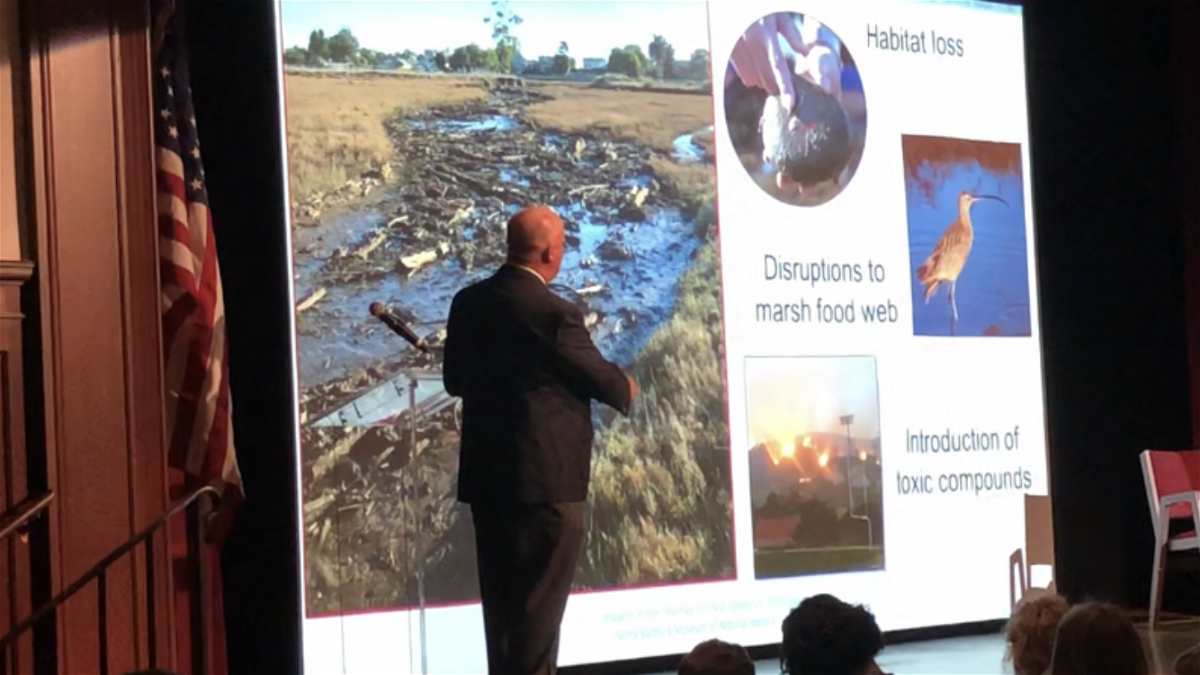Disaster readiness and impacts discussed at packed auditorium in Santa Barbara

SANTA BARBARA, Calif. - Impacts to the natural environment after the Montecito mudflow and Thomas Fire were detailed in a panel discussion at the Museum of Natural History in Santa Barbara Sunday.
Experts from scientific, government and educational areas shared their research and analysis two years after the events.
"The Thomas Fire and the January 9 (2018) debris flows had terrible impacts on our community," said Museum President Luke Swetland as he started the event.
He said the events had impacts on our natural systems and regional ecology. He asked for a moment of silence for the 23 who died and those still in recovery.
He said the area has much to learn as it moves forward.
Dr. Andrew Brooks with the U.C. Santa Barbara Natural Reserve Group gave an example of the debris volume that came out of the Carpinteria hills.
He said the equivalent of 19,500 dumpsters of debris ended up in the Carpinteria Salt Marsh. It came out of the hills through Franklin and Santa Monica creeks heading to the ocean.
Brooks said the marsh is a "hot spot of biodiversity."
The weather event caused "quite a bit of habitat loss," he said. Oysters, crabs, shrimps were completely suffocated. They are food sources for shorebirds in the area.
Instead of an immediate cleanup, "what we chose to do is to step back and learn," he said. They watched the natural recovery which experts say will take some time.
These days he says, researchers say "it is able to partially recover on its own but not fully recover," said Brooks.
Other experts spoke about the impacts to the near shore ocean waters in Goleta where sediment was dumped and the loss of a portion of the kelp forest along our coast.
Future events may mean more debris basin clearing and the Santa Barbara County Asst. Public Works Director Tom Fayram said a closer dumping site than Buellton or Santa Paula (where many trucks hauled the debris) needs to be found.
Getting permits before an event to handle projects such as debris basin clearing is often done by Santa Barbara officials and they were in the timeline around the fire and mudflow. "They were in place," said Fayram.
He is also hoping an area will be found to sort the debris coming from basins and the hills in order to decide what should go to the ocean and what should go elsewhere. Fayram said that is one of the biggest challenges ahead when it comes to debris management.
The most significant impacts to the watershed from the fire were in Ventura County and Carpinteria
Fayram said more material was moved in the rain events 25 years ago. "We actually moved more material in 1995 that we did in the debris flow because it was across the entire South Coast."
Many of the speakers said the recovery was still underway and will take years.
Those attending were asked to use their phones and a special interactive questionnaire to share with the panel their thoughts about their level of readiness for a disaster and whether or not they felt the government was prepared enough. They also gave feedback on their takeaway from the conversations.
The event was coordinated by The Santa Barbara Museum of Natural History, the UC Santa Barbara Bren School of Environmental Science and Management, the Community Environmental Council, Santa Barbara Channelkeeper and the Santa Barbara Foundation.
The panel of speakers were:
– Sarah Anderson Ph.D., UC Santa Barbara, Bren School of Environmental Science & Management
– Andy Brooks Ph.D., UC Natural Reserve System
– Tom Fayram, Santa Barbara County Flood Control
– Steven Gaines Ph.D., Dean, UC Santa Barbara, Bren School
– Mauricio Gomez, South Coast Habitat Restoration
– Brandon Steets P.E., Geosyntec Consultants
– Ben Pitterle M.S., Santa Barbara Channelkeeper
– Kim Selkoe Ph.D., National Center for Ecological Analysis and Synthesis
– Sigrid Wright M.A., CEO, Community Environmental Council
To watch the panel discussion click here.
